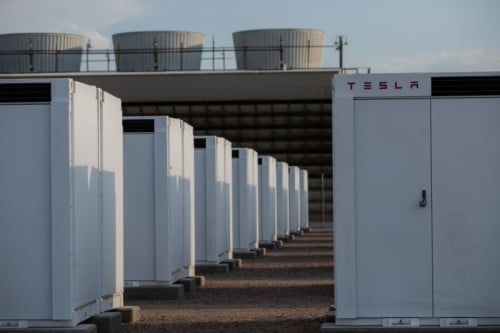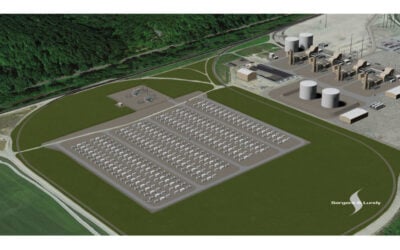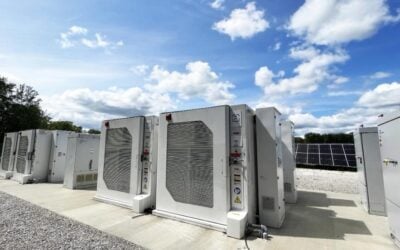
In the third quarter of 2021, almost as much energy storage was deployed in the US as was recorded for the whole of 2020, when the industry surpassed a gigawatt of installations for the first time ever.
According to the latest quarterly US Energy Storage Monitor report from Wood Mackenzie Power & Renewables, between July and September this year 1,140MW / 3,515MWh of energy storage were installed in the country.
Enjoy 12 months of exclusive analysis
- Regular insight and analysis of the industry’s biggest developments
- In-depth interviews with the industry’s leading figures
- Annual digital subscription to the PV Tech Power journal
- Discounts on Solar Media’s portfolio of events, in-person and virtual
The research and analysis firm had said at the end of last year that 1,464MW / 3,487MWh of new energy storage had gone online in the preceding 12 months. This in turn was more than had been deployed in the US in six years prior, from 2013 to 2019.
In other words, Q3 2021 saw the greatest quarterly deployment figures on record in megawatts, with 612MW more deployed than in Q4 2020, the previous record holder.
As before, activity was largely driven by front-of-the-meter, utility-scale energy storage with close to a gigawatt of installations (998.8MW). It’s unlikely to be surprising to regular readers of Energy-Storage.news that most of that was in California.
However, there was also growth in the residential and non-residential (commercial & industrial, community etc) segments. A quarterly total of 97.9MW / 225MWh of residential installations were logged and 43.6MW / 92.1MWh in non-residential — that segment’s highest figure for 2021.
Durations are increasing in the energy storage market, with the average front-of-the-meter project having 3.2 hours of storage duration. Again, this average was largely bumped upwards by California, where four-hour duration projects are increasingly typical, due to contracts for Resource Adequacy (RA), the market mechanism by which grid operator CAISO ensures energy suppliers are able to meet their capacity obligations.
The residential average duration was 2.3 hours, while non-residential projects’ average duration was 2.1 hours.
California tops utility, residential segment rankings
California’s front-of-the-meter lead with 2,744MWh of Q3 deployments was followed by Texas with 304MWh and the top three was rounded out by Arizona, with 100MWh of new deployments.
In non-residential, Massachusetts, driven by policies like the Solar Massachusetts Renewable Target (SMART) programme and Clean Peak Standard, came first with 44.6MWh of deployments, followed by New York (21.8MWh) and then California (16.8MWh).
California led residential installations (88.8MWh for the quarter), with Puerto Rico in second (29.9MWh) and Texas (16.8MWh) in third. Each of those markets has not only strong residential solar markets but also an increasing demand for resiliency and back up in the wake of extreme weather and outages over the past few months or years.
Having previously forecast that the US’ energy storage market could be worth around US$5 billion for 2021, the analysis firm pushed that upwards to a forecasted value of US$5,844 million. Between this year and 2023 it is expected to almost double to US$10.41 billion, with front-of-the-meter continuing to dominate deployments.
While the market’s growth from there onwards will flatten somewhat, Wood Mackenzie analysts said, by 2026 it will be worth a total of about US$11,546 million.
The US Energy Storage Monitor is published in cooperation with the national Energy Storage Association (ESA). ESA interim CEO Jason Burwen commented that the record-breaking quarter showed that “the game of power system investment has officially changed,” around energy storage, the “game-changing technology”.
“The Storage Decade has arrived,” Burwen said.
Wood Mackenzie storage analyst Vanessa Witte noted that the firm expects up to 4.7GW of utility-scale storage to come into operation in 2021.
In other words, the record-breaking quarter is “only the beginning of a wave of major new projects set to come online this year and next”.
That being said, some developers have reported slight delays to their projects during this year and some front-of-the-meter (FTM) projects scheduled for completion in Q4 could be pushed back to early next year, Wood Mackenzie said.
So far, only 1.8GW of FTM has come online in 2021 but more than 2.9GW is still expected to become operational. There is a growing trend for hybrid systems, mostly solar-plus-storage, with just under half of operational projects pairing generation with storage.
The research group has also modelled a significant upside to market growth if President Joe Biden’s Build Back Better Act can be passed into law, including the introduction of investment tax credits (ITC) for standalone energy storage.
This week, Energy-Storage.news published an in-depth interview with ESA CEO Jason Burwen and Heather Zichal, CEO of the American Clean Power Association (ACP). The two organisations are set to merge, effective as of 1 January 2022. Burwen and Zichal said that this is reflective of energy storage’s integral role as an enabler and complementary technology to wind, solar and transmission.






